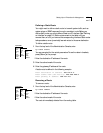
Setting Up an IP Interface for Management 3-3
Setting Up an
IP Interface for
Management
IP is a standard networking protocol used for communications among
various networking devices. To access the system using TCP/IP or to manage
the system using SNMP, you must set up IP for your system as described in
this section.
General Setup
Process
You must first define an interface, which includes assigning an IP address to
that interface, and then ping your IP management station to ensure that the
connection is alive.
Assign an IP host address to every port for system management.
Then you can finalize your IP setup by ensuring that the configurations of
the following are correct for your network and changing them as necessary:
■ Routes (See page 3-7)
■ Address Resolution Protocol (ARP) cache (See page 3-11)
■ Routing Information Protocol (RIP) (See page 3-12)
You can monitor IP activity for your system by displaying the IP statistics at
any time.
Administering
Interfaces
You define interfaces to establish the relationship between the ports on
your system and the subnets in your IP network. You can have up to 32
addresses on a single port and you can assign up to 17 ports per interface.
An IP interface has the following information associated with it:
■ IP Address
This address is specific to your network. Choose it from the range of
addresses assigned to your organization. This address defines both the
number of the network to which the interface is attached and the
interface’s host number on that network.
■ Subnet Mask
A subnet mask is a 32-bit number that uses the same format and
representation as an IP address. The subnet mask determines which bits in
the IP address are interpreted as the network number, which as the subnet
number, and which as the host number. Each IP address bit corresponding
to a 1 in the subnet mask is in the network/subnet part of the address. Each
IP address bit corresponding to a 0 is in the host part of the IP address.


















